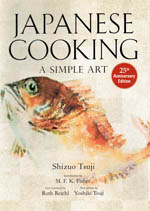Ingredients:
- 4 slices pork loin or tenderloin, about 1/2 inch (1.5 cm) thick and 4-6 ounces (115-180g)
- freshly ground black pepper
- salt
- flour
- 2 eggs, lightly beaten
- 2 cups fresh or dried bread crumbs
- oil for deep-frying
- shredded cabbage
- lemon wedges (optional)
- commercially prepared tonkatsu sauce, or a combination of the follwing mixed to taste:
- ketchup
- Worcestershire sauce
- dark soy sauce
- prepared mustard
- sake
4 servings
Tonkatsu, deep-fried breaded pork cutlet, is in its own way just as famous as tempura; and like tempura it was imported from the West. This dish is derived from the European breaded cutlet, but whereas the Western version is fried in a scant amount of oil, this one is deep-fried.
Tonkatsu is one of the most popular meat dishes in Japan. A "set" meal consisting of a deep-fried breaded pork cutlet on a bed of cabbage, a bowl of rice, one of soup, and a side dish of pickles costs about Y800-Y1,000.
In comparison with tempura, this dish might impress you as being heavy, almost Germanic. But the fact remains that this kawari-age dish is very much a daily food and is inexpensive as well as filling. Done well, with pork loin or tenderloin, it can be very good indeed.
Tonkatsu is accompanied by a thick sauce, based on Worcestershire sauce, which is available in bottles, or you can use the dipping sauces recommended below. It is commonly laid against shredded raw cabbage, which acts as a salad.
Directions
To prepare: In a few places slash the fat rimming one side of the loin cutlet to keep meat from curling when deep-fried. Salt lightly then grind fresh pepper over both sides. Dredge lightly in flour. Dip into beaten egg and then press into breadcrumbs.
To deep-fry: Bring about 3 inches (8 cm) of oil to about 350° F/175° C in a heavy-bottomed pot or deep-fryer. Lay 1 or 2 cutlets in the hot oil. Deep-fry till golden brown, about 5 to 7 minutes, turning them in the oil once or twice. Skim the oil periodically.
Briefly drain cutlets on absorbent paper. Cut pork crosswise at 3/4-inch (2cm) intervals into bite-sized slices that are easy to manage with chopsticks. If you plan on eating tonkatsu with knife and fork, do not bother to cut it at this point.
To serve: Against a generous half-plateful of shredded cabbage, arrange cutlet slices as if cutlet was whole. Garnish with a wedge of lemon, if desired. The sauce may be poured from a small ewer into a small bowl to be used as a dip, or it may be poured over the cutlet and cabbage.

Reprinted with permission from the book:
Japanese Cooking: A Simple Art
Kodansha International
Easily the most comprehensive and exhaustive look at Japanese cuisine available, this groundbreaking classic marks its quarter-century anniversary in a revised edition with a new foreword by Gourmet editor-in-chief Ruth Reichl and a new preface by the late Tsuji's son, Yoshiki Tsuji.
Part cookbook, part philosophical treatise, this highly acclaimed collection offers a wealth of insight for amateurs and experts alike. Every technique associated with Japanese food is described step by step in great detail, along with illustrations to guide the reader through everything from filleting fish or cleaning an octopus to rolling omelets.
Sections on the Japanese meal, ingredients and selecting and cutting fish, chicken and vegetables offer great insight into the culture as well as the food. The recipe section of the book is divided by cooking method rather than food type, including grilled and pan-fried, steamed, simmered and deep-fried.
Dishes range from the simple, Pan-Broiled Salmon, to the more complex, Nagasaki-Style Braised Pork, and many dishes are vegetarian. Sushi and sashimi are covered in depth, as are knives, the proper way to slice the fish, and decorative presentations.
A complete guide to Japanese cooking, this collection is must-have for anyone interested in Japanese food or culture.
ISBN 978-4770030498
Y4800
- Order this book from amazon.com
- Order this book from amazon.co.jp (in Japan)
- Find this book at your local English-language bookstore in Japan
- Or use the ISBN to order from your local bookstore.







